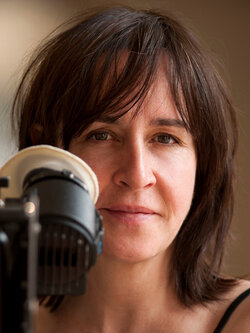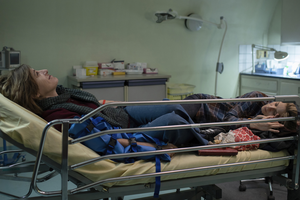Interview with Jeanne Lapoirie, AFC, about her work on "La Fracture" by Catherine Corsini
How did this project come about?
Jeanne Lapoirie: The film came together quickly, on the basis of a personal experience: Catherine found herself in the Lariboisière emergency room after a run-of-the-mill accident. Of course, it wasn’t during the Yellow Vests revolt, but she soon came up with the idea of mixing her personal experience with a retelling of those events. The emergency, properly speaking, occurred with the arrival of the public health crisis and the resulting impossibility of shooting a film inside of a hospital.

Where and when did you shoot?
JL: Shooting began in late September2020 and ended with the second lockdown in November. Most of the hospital scenes were recreated in a single location, a former Airbus building located in Suresnes, which had the advantage of already having a lot of features that resembled a hospital. The location was located in the first basement level (like the Lariboisière emergency room) with floor outlets, lots of useable walls, and in the end, it required few costly modifications. Only a few scenes, which required heavy equipment (X-ray machine, CAT-Scan) were filmed in a private clinic and a hospital in Lyon.

What about COVID?
JL: We had absolutely no problems on set. The producers were very worried about the pandemic and had hired a very serious COVID consultant. When you see the type of scene like the influx of a group of demonstrators coughing because of the riot police’s tear gas, you realize that we really did have to do something about it because of how close the extras were to one another and given that it was impossible for them to distance themselves from one another. Only Pio Marmai had to quarantine at one point, because he’d tested positive, but that was at the very end of shooting in Paris, which just required us to push our shoot in Lyon back by a week.
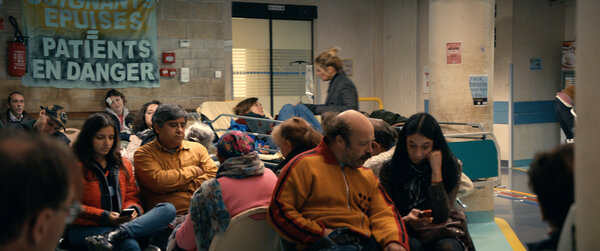
You also had to recreate a scene that was set during the first weekend of Yellow Vest demonstrations…
JL: At first, we were supposed to shoot in the 8th Arrondissement of Paris, but as more and more health restrictions began to be implemented, our permit got cancelled. We had to find a B plan and we thought about shooting in studio with a LED wall. But the cost – for a single day of shooting plus two façades of several dozen meters that would have to be rebuilt in studio, plus a LED wall between them to lengthen the view down the street – was simply prohibitive. We and the producers decided to fall back on a private outdoor location, with green screens stretched out on frames so that we could make it fit with a Parisian street. We chose a courtyard in the Château de Fontainebleau. The side walls of the courtyard formed the walls of the street. Several green screens were set up behind the demonstrators, and they hid the entrance to the courtyard. The CRS’ side was left as-is, and the mass of masked extras and trucks made it easy to do a simple rotoscoping job without having to do extraction. I was quite worried about how the scene would turn out, visually speaking, but I must admit that everything went really well in the end. As for the directing, Catherine also relied a lot on side shots, which weren’t digitally modified, which made the postproduction work a lot easier.

What was your technical setup on this scene?
JL: I set up six 6-meter by 6-meter frame. Nothing was relit in terms of the backgrounds. The green on each frame wasn’t exactly the same… We organized it so that we’d put the darker ones in the angle that had more light and put the lighter ones in the shadow. We also decided to use real smoke in the courtyard to avoid having to add in fake digital smoke during post-production, which always looks a bit artificial because of how uniform it is in its depth. Despite this extra handicap, the Lux Populi FX team did a great job.
How did you shoot?
JL: The whole film was shot with one camera, mainly on the shoulder (EasyRig) – except for a few scenes (demonstration, car bringing in front of the hospital, and fall of Valeria’s character) where we needed a second camera. Catherine wanted a dynamic film, even though we were inside the closed world of the hospital. She likes a lot of camera movements and following the actors, for example. The presence of Valeria Bruni Tedeschi, and the fact that I’d shot and lit almost all of the films she’s made as a director, allowed me to feel confident in proposing long takes that covered almost the entire scene. Allowing the actors to come freely into the scene, and then later cutting out the parts that weren’t as good, or allowing them to correct or rework their performance, or reshooting the angles we hadn’t gotten… The idea was to make a master with a handheld camera that could change a bit in function of the take and shooting without rehearsals.
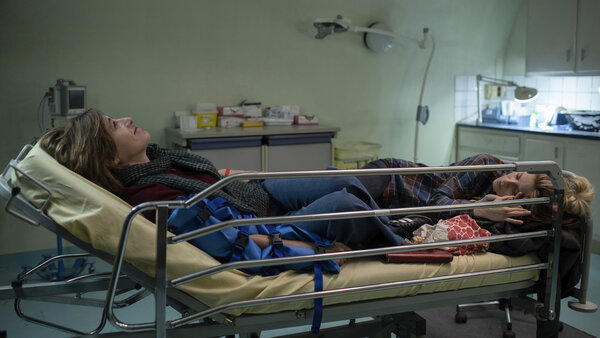
Without any rehearsals?!
JL: I like doing it that way. I think that shooting the actors while they aren’t totally ready introduces a fragility and other thing that you can’t regain later on, once everything has been put into place, when there are no longer any surprises, and there is less live… I always prefer chance and accidents on set, and when you shoot a rehearsal, that’s when you’ve got the most chances for that to occur. I’ve often noticed that the actors also agree and that having long shoots often allows them to be more immersed in the scene, and some of them enjoy not rehearsing. It does make things more difficult, particularly for the sound crew who has to improvise every time the camera starts rolling. Editing, too, can be a bit more complicated at times, because the actors’ performance is often very different from take to take. Especially as concerns Valeria, who is constantly trying and seeking to do better with her performance.
Did you do research beforehand?
JL: When I first read the screenplay, I went looking for ideas in hospital films… A Scorsese film came to mind (Bringing out the Dead, cinematography by Robert Richardson, ASC) but it was really just too Hollywoodian for me. In order to center myself on a more French feeling, I watched Raymond Depardon’s Urgences, shot at the Hôtel Dieu hospital… Then, Catherine Corsini got a hold of photos taken by a young reporter named Corentin Fohlen. He was the author of a report on the Hôpital Lariboisière. What was great in his photos was that you saw a place that was very far from the idealized, aseptic, and very white images one often sees of hospitals. His photos were dark, with very strong light effects, a lot of contrast… darkness was often more present than light. I thought that this was a perfect reference for our project and my gaffer, Nicolas Dixmier, and I, used them. For the set design, Toma Baqueni and I sometimes opted for darker choices for the color of some walls, rooms, etc. One of the triage rooms is a good example of that, where we used brown and even black walls. That’s something we would probably never have dared to do without having seen the photos, even though in reality those really are the colors of one of the triage rooms at Lariboisière. I also kept a few breaks very lighter and white, such as a few hallways.
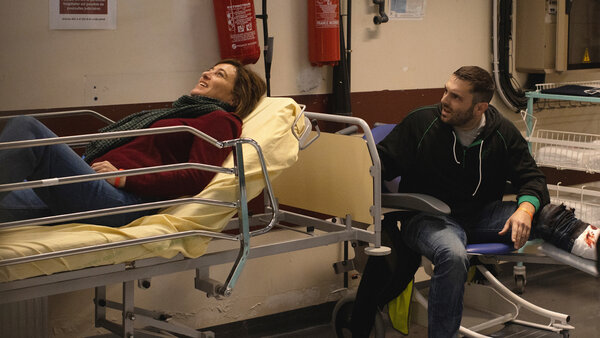
At the heart of the film, when everyone is in the hospital, the image does change somewhat. Do you have a theory as to the way the image changes throughout the film?
JL: Not really, I just had the rather logical desire of opting for darker ambiences as the film goes further into the night. On the main set (the basement reconverted into a hospital), we entirely prelit the scene with a lot of LED lights on the original ceiling fixtures. The set design crew didn’t have the budget to rebuild the ceilings, so we proceeded as though we were in studio, with a technical grid entirely controlled by WiFi on tablets, all of which were low and often were visible in the frame. The absence of ceiling also had a repercussion on the image, because no light could be reflected from above, which drastically increased the contrast on the faces. Then, in the box location where Valeria is asked to wait in the second part of the film, we were able to set up a few white reflectors as a ceiling, which softens the ambience a bit. This was good for Marina’s face, as she, unlike Valeria, isn’t lying down facing the vertical light, but is rather standing, and this is less flattering.
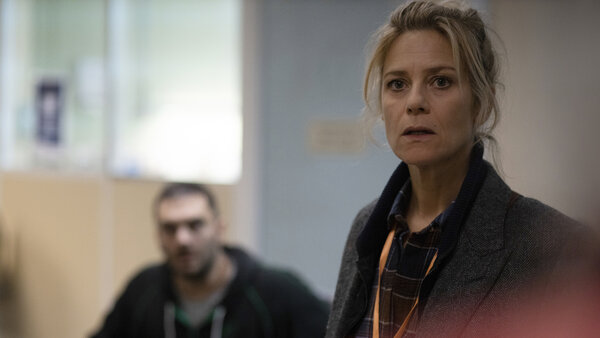
Did you use any additional lighting besides your ceiling?
JL : There was almost no light on a stand. Just a little carried lamp was used to light the faces. The set was lit 360° with a complicated ballet between the perchman, the spark and the assistant cameraman. I used an Alexa Mini, as on all of my films. On this film, we decided to shoot it in anamorphic. I mainly shot using an Optimo 56-152mm T4 zoom and a fixed series. But for the night outdoor scenes, I didn’t have enough aperture and I wanted to keep the zoom to be more mobile and more reactive. So I shot those scenes in spherical format, cropped to Scope format with the 28-76mm and 45-120mm Angénieux Optimos, plus the prime lenses in case of a major lack of aperture. This was a daring choice but in the end, it all spliced together very well.
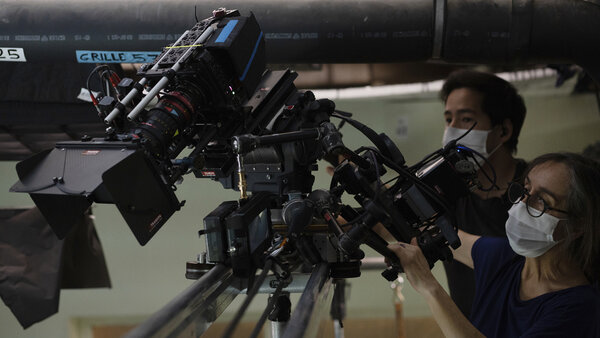
The scene where Raf (Valeria Bruni Tedeschi) falls in the stret has a very particular, and very dense, sunlight…
JL : This scene was shot at the end of the shooting schedule, in early November, while lockdown had already begun. Cafés had closed and we were restricted in terms of the street. In the screenplay, this scene was supposed to take place at the very end of the day so that it could be spliced together with Valeria’s arrival at the emergency room after sundown. But, given the difficulty of organizing permits, we were forced to shoot on a Saturday morning. We’d hoped to shoot in cloudy weather, but of course it was a sunny day, but overcast at times, unfortunately. It was impossible to have sun or clouds alone… Catherine was worried about the sunlight while we were shooting. I was hoping she wouldn’t only choose the sunny takes. It was the only time in the film where we might have had sunlight, as the rest was at night in the basement! During color grading, Catherine was afraid about the bridging shot with the following scene, which was supposed to be at the end of sundown and at the start of the night. She wanted us to try to stretch out the sun as much as we could, but we all know that the result is always a disappointment. So, we instead chose to accept the idea of a sunny late afternoon day, and then we color graded it densely to make it really look like it was the end of the day. Then, we just accepted the stretch of a bridging shot with the next scene with the arrival at the emergency room. Personally, I love the sun and I think it always looks great on screen!
Raf and Julie are a couple on the verge of a breakup, and they meet in a nearly suffocated emergency room on the night of a Yellow Vests demonstration in Paris. Their meeting with Yann, an angry and wounded demonstrator, dispels each of their prejudices. Outside, the tension continues to rise. The hospital, under pressure, must close its doors. The staff is overwhelmed. The night will be long…
Interview by François Reumont translated from French by A. Baron-Raiffe, for the AFC.
 En
En
 Fr
Fr